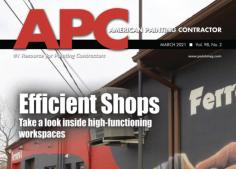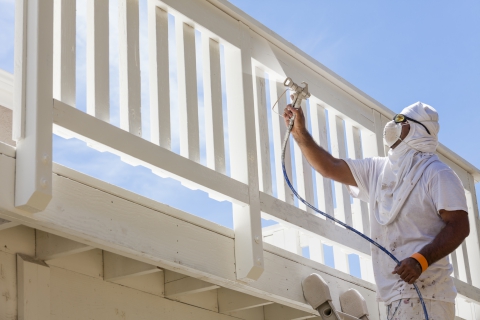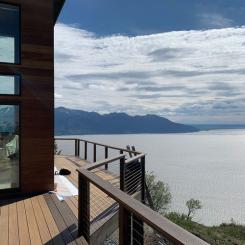When painting Azek or other synthetic exterior products, do you prep and paint the same as with wood or do they require special treatment?
Mark King, MAK Decorating Chicago, Illinois
My company does carpentry and painting, so we deal with both installation and finishing in exterior trim replacement situations. We mostly see and use Azek or similar products on exterior corner boards.
The prep process is pretty similar to when we are working with exterior wood trim. Basically, we scuff sand (with just a sponge block) and paint with a premium satin paint. Primer is not required on most synthetic trims, and most higher-quality exterior latex paint formulations adhere really well on synthetic products. I have had really good luck with Benjamin Moore Aura exterior paint on Azek.
When nail hole filling is preferred, we set the nails – but not too deep – and fill with 3M Patch Plus Primer.
I typically use Azek in long lengths, so there aren’t many miter or butt joints. Twelve-foot runs are pretty typical. I have heard that these types of products expand over their length, unlike wood, which expands and contracts side to side across its width. By minimizing the number of joints, there is less likelihood of a blowout in the joints.
Azek is kind of sandable, but it is important to understand that when you sand it, you lose the smooth, shiny top surface. Since the product is very porous underneath that, there is some feathering that would go into keeping a sanded area from flashing. Speaking of porosity, the end grains of a cut piece are highly porous and should be sealed with primer, paint or caulking – especially if they are down near the ground.
Overall, I would say that working with products like this isn’t a whole lot different from working with exterior wood trim. Similar processes, products and concerns for protection are involved.
Exterior stain versus paint – which is better on exterior wood?
John Shearer, Shearer Painting Seattle, Washington
If it is a very high grade of wood stock, like old growth cedar, stain works really well. If it is newer wood material, it is better to paint it because the newer growth wood product is generally not as thick, tight or resilient as older growth boards.
That is my overall, big-picture opinion of paint versus stain. That’s not saying anything about aesthetics; I am just talking about the treatment and protection of the wood. Old growth shingles that are an inch thick, for example, can be exposed to the weather for decades and not show any damage except possibly for ultraviolet and blacking. But that doesn’t warp the shingle, and it can be cleaned, maintained and go on for more decades. So, quality of the substrate is a big part of the decision of choosing what is going to work best on it.
There is a product we use from Cloverdale Paint called SharkSkin. It is an acrylic hybrid solid stain that is formulated for use on decks and siding in harsh and wet climates. It is an impressive product for paint contractors who are looking to check out alternatives to exterior prime and paint systems.
Do you deal much with factory-primed wood? If so, how do you handle it? Do you reprime it? Any special prep?
Joe Elmore, Armor Tough Coatings Commerce Township, Michigan
We don’t see a lot of factory-primed wood, but it is important for us to have procedures in place for when we do. As a rule, we normally sand smooth and apply another coat of primer just to be safe. We do any repairs before we prime, then we determine the primer we will use depending on what the topcoat is.
For us, it’s more of an insurance policy, as it seems like the primers used on factory-primed items are often a cheaper quality and very, very thin. I have even been told by manufacturers that sometimes items are preprimed only for protection between their point of manufacture and their delivery to the end user.
Take, for example, metal doors. It is in the manufacturer’s best interest to at least have something on them so they don’t flash rust before being sold and installed. It’s possible that wood suppliers look at it the same way, where even a thin coat of cheap primer would be better than nothing to keep the wood dimensionally stable, because who is going to buy cupped and warped wood?
I think that’s part of the thought process that pros have to consider when making the decision on whether to trust the factory primer or to prime over it. To me, it is cheap insurance.
If we are doing a job where the customer may want to save money, then we may just prep the primer and paint right over it, but we always start a quote assuming that we would prep and reprime.
.jpg)
.jpg)
_0.jpg)




Add new comment